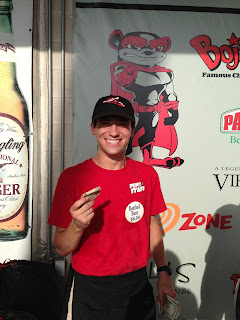Carnegie Mellon University barely touches UPitt, and yet the campus has such a different feel to it. Surrounding by buildings and open quads, you wouldn't know you were in a densely populated city. Of course, today Pittsburgh was back to its "usual" weather of cloudiness, humidity, and rain. Blacksburg, take notes.
Our workshop was held in Hamerschlag Hall, which sounds more German than Otto von Bismarck eating schnitzel in a fresh pair of lederhosen. The building houses most of the engineering department and its labs, and while getting lost, I came across a huge conference room/lab that looked just like the UN. No shortage of funding here.
 |
| Hamerschlag Hall would fit in just fine in D.C. There's also five floors below this one, with windows facing out towards the rest of the city. |
We met Dr. Ruder's colleague Lina Gonzalez and several interested CMU undergrads on D floor, four floors below the hall's entrance. This workshop was meant to explain the idea behind soft lithography, an effective method for creating microfluidic devices.
Lithography was originally used in the art world: professional lithographers, sometimes students of famous artists, could effectively recreate a work by laying layer upon layer of ink and other material until the image is completely rendered. These students then sold their work; the better the quality of their re-creation, the higher the buying price.
Now this technique has been adapted to craft microfluidic channels, as seen in "lab on a chips". There's about five steps in the process, and if you're not careful in any step, or leave your material on a hot plate for too long, you have to start over. A warning:
 |
| I apologize if I get too technical. But the man who passes the judgment should swing the sword. |
The dimensions of the channel itself are sketched out on AutoCAD, sent out to a company with a high-resolution printer, and the transparency is promptly returned. Next, the master template is made on a silicon wafer with SU-8 photoresist, a very viscous polymer.
A series of UV and hot plate treatments follows, and then a developer solution is added along with several other reagents. Placed in a vacuum, the photoresist polymer not bound to the silicon wafer is washed away, leaving only the AutoCAD design. The duration of UV and hotplate exposure it critical; the thinner the channel, the shorter the treatment time.
 |
| The wafer/photoresist solution in a vacuum. |
 |
| That's developing solution in hand on the left. It washes away the portion of the photoresist not exposed to the UV light, AKA everything but the master mold. |
Next, we added PDMS (Polydimethylsiloxane) to the master mold template and mixed gently. The mixture was then heated to "cure", or harden, the PDMS polymer. The section of the polymer was isolated and the PDMS layer, now with the channel pattern imprinted was peeled from the wafer.
A special kind of needle was used to poke holes at ends of the channels for adding nutrients, treatments, and the like. But the side of the hardened PDMS with the imprinted channel is open to the air. To fix this, the PDMS and a clean glass coverslip were placed in a plasma cleaner, which cuts off a small layer of electrons from the surface. Now, the PDMS and the glass can covalently bond, forming an airtight system. It was impossible to pull apart with sheer force.
 |
| The final product. That white circle is a needle insert, and you can see the branching of the channels as transparent lines. |
We got to keep the channel above as a keepsake, it makes a really good . And the CMU crowd were welcoming folks, too. The workshop gave us a great start for how we can re-create and use something like this for our own projects.
Cheers,
Ben



























































